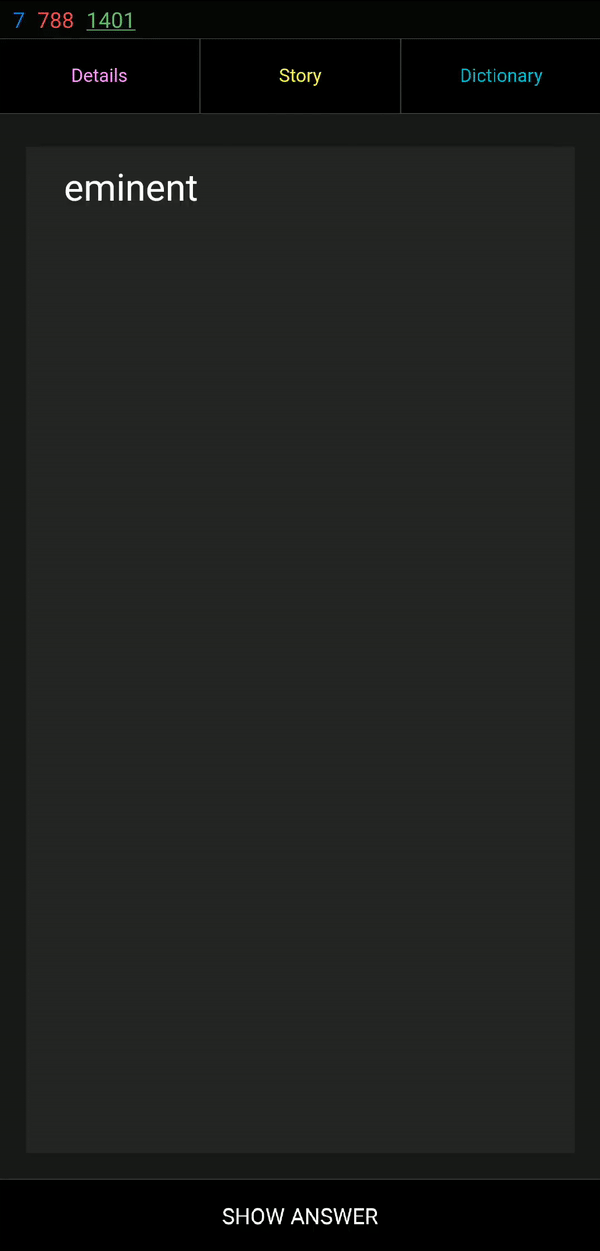-
A ready-to-bake deck containing almost all the information you could ever need to study Kanji. [1]
-
Flaring card design. Inspired by Kanji Koohii, designed with AnkiDroid Card Preview
-
Scripts to migrate everything from Kanji Koohii to Anki.
|
❗
|
I just discovered that you can toggle the Story, Details and Dict buttons without exiting the Whiteboard mode! You just need to tap and hold one finger anywhere in the screen while pressing the desired button with another. |
If not, you can start by watching this video on the basics on Anki. You can also read the manual if you get lost.
-
Download and extract the latest release of Koohii2Anki.
-
Download your stories and keywords from Kanji Koohii.
-
Save the file to the
importCSVdirectory (it should be namedmy_stories.csv) -
Run
getstories.-
If you are using Windows, I’ve provided an exe for simplicity.
-
If you are using Linux or MacOS or you are comfortable with a terminal, you should follow the extra steps
-
-
Import
SkeletonDeck.apkginto Anki. -
Delete the demo card that comes included with it.
-
Import
Formatted.txtinto Anki. -
Move
_jquery-3.7.1.min.jsinto your collection.media directory
You should now have a new deck called Remembering the Kanji in Anki.
-
Download your progress from Kanji Koohii.
-
Download these addons:
1340694622 1947297285. (Source 1 Source 2.) -
When the download has finished, restart Anki
-
Click on Tools › Kanji Colorizer for RTK to generate stroke order diagrams.
ℹ️If you are using the 4th edition of the book, change the following plugin configuration files to reflect your version. You can do this in Tools › Add-Ons, select the "Import Kanji Koohii Progress" addon and click on config. -
Click on Tools › Import Kanji Koohii Progress and select the
rtk_flashcards.csvfile you downloaded earlier.ℹ️Anki can seemingly not respond while executing the plugins. This is normal. Give it some time.
Phew! That’s it! 🎉🎉🎉🎉
If you have already finished RTK or you are working on Core2K simultaneously, you should definitely look into Kanji Vocab an Add-on that links vocab with kanji.
The deck comes with predetermined styles for smartphones so if you have the 6th edition and you’ll be reviewing on mobile, skip this part.
-
Hit B and select the Remembering the Kanji deck on the left.
-
Hit Ctrl+L or the Cards button
|
ℹ️
|
If you are using the 4th edition of the book, you’ll want to change the |
The Styling field’s font-size: needs to be adjusted to adapt to screen size.
Decide which device size you’ll be using the most (from best to worst support):
-
If you choose a smartphone, you should choose a value of around
.45em(default) -
If you choose a tablet, you should choose a value of around
.4em -
If you choose a desktop computer, you should choose a value of around
.3emExperiment with the values to see what works for you
If you can’t run the getstories.exe you can use the uncompiled Python version.
-
Make sure that you are running Python 3 by running in a terminal
python --version
and
pip --version
ℹ️If on any of these commands you get Python 2.x, you should look into getting python 3 into your PATH. -
Install pandas.
python3 -m pip install --upgrade pandas
-
Run the script (remember cd’ing into the
importCSVdirectory) with:python getstories.py
Tl;dr Anki is better.
-
With Koohii Forums closing down on 2019, we got reminded that the Kanji Koohii depends on a man and a few contributors. If someday the site gets nuked, all the reviewing system and personal progress will be deleted too.
-
The site’s development is stalled. Although KK has been open sourced some time ago, no major improvements have been done since. What’s more, Fabrice, the main developer of the site, has publicly announced to have switched the site to maintenance mode.
-
When I began my journey through Japanese, I was eager to go and jumped straight into RTK and KK. After completing RTK1, I began studying with Anki. My world was shook. It was so much better; plugins, card styling, better failed card handling, portability, configurable SRS, offline capabilities, FOSS. I decided that switching from KK to Anki was to be my next step.
-
The portable reviewer for KK (Android) is not open source, hard to install and a bit dated. For those of you who don’t know, Kanji Ryokucha is an app that allows you to review RTK on the go. It has many advantages over the website such as stroke order and a scratchpad to write. Unfortunately, it is dependent on the internet to get the cards.

